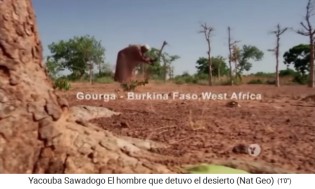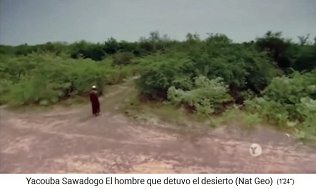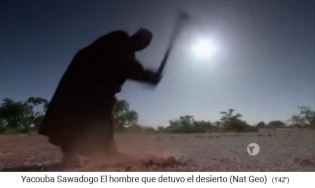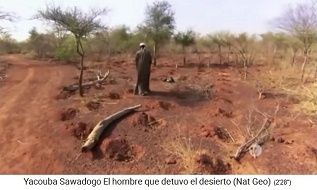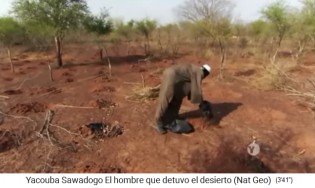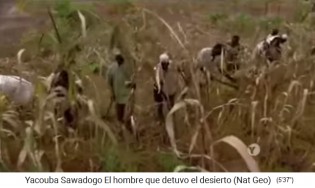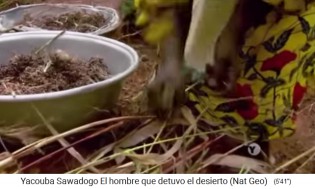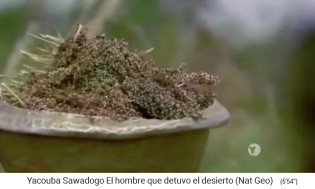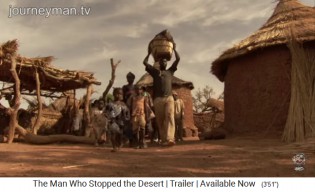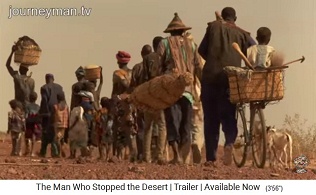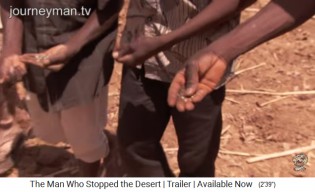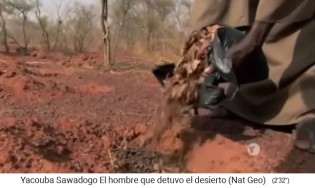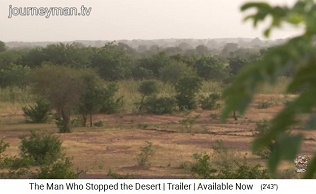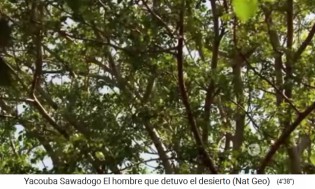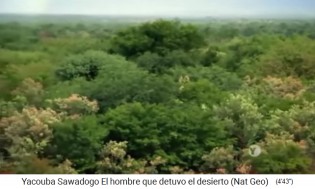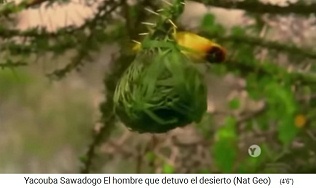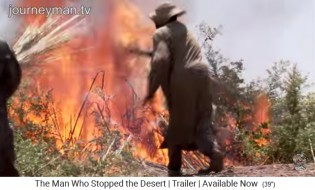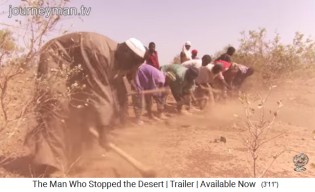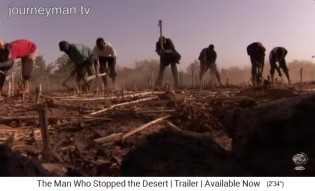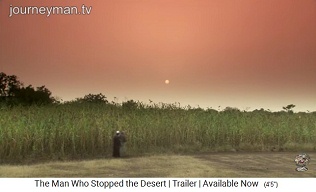1. The dryness - the large holes in the ground (Zai
holes) filled with manure, compost and leaves
Central Africa suffered long periods of drought from 1975
to 1985 [HAARP manipulations] and the soil became hard,
barren, the wells dried up and the villagers migrated
westwards to the cities or to other countries, e.g. to
Ivory Coast (20'2'').
Film title: The Man Who Stopped the
Desert - Burkina Faso: Drought and exodus from Gourga
village (film scene) - Exodus from Gourga village west
towards Ivory Coast (film scene)
Agriculture in Central Africa has long worked with holes
in the ground (zai system): In the hard desert soil in the
village of Gourga, holes were always chopped into the
ground (zai) for planting. But Yacouba Sadabogo expanded
the Zai method: He dug deeper and wider holes and covered
put manure in it and compost (leaves etc.) over it, so
that the sown plants would grow even better when rain is
coming. He also drilled the holes during the dry season,
so that even in the dry season moisture formed in the
holes already, which was against tradition (22'52'').
The old people in the village who had the say were against
Yacouba and defended the tradition that one should have
nothing to do with harvesting before a certain month, and
certainly not carry compost into the holes (23'42'').
Digging Zai holes before the rainy season was unimaginable
to the old people in the village (23'48''). Yacouba said
he simply dug a few holes, and if the old men call it
"zai", that is their problem (24'7'').
With his variation of the Zai technique, Yacouba was able
to allow new forests to grow in his region and new springs
to spring up because the groundwater level was rising
(24'50''). All the "experts" from Europe were amazed of
Yacouba and its combination of simple techniques that the
European "experts" themselves had not found (25'12'').
Gourga in Burkina
Faso, new forest of Yacouba Sadabogo - Gourga in
Burkina Faso, Yacouba Sadabogo walks into his forest
2. The rows of stones slowing down the rainwater
As a second measure, Yacouba had installed rows of
stones over entire areas to slow down the speed of the
rainwater in the rainy season so that the water tends to
seep into the ground (29'19'').
Stone rows against fast water runoff
1,2,3
The combination of Zai holes with compost and the rows of
stones slowing rainwater runoff was the winning
combination (29'25'').
3. Termites are building tunnels in the soil - fourfold
absorption of rainwater
As a third element, Yacouba added termites to his system.
The termites are the element to revive the compacted soil
(29'57''). The dung is attracting termites because fungi
are formed in the earth holes, which are the food of the
termites. The termites are digging around in the earth,
are digging tunnels, are eating leaves and are helping the
soil to absorb
four times the normal
quantity of rainwater (30'44'').

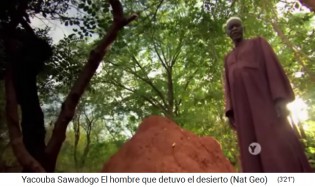
Yacouba Sadabogo hacking a termite mound - and telling
about nature standing next to a termite mound

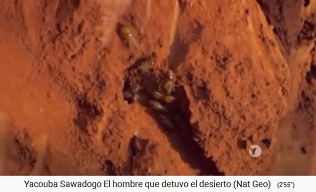
Die Termiten tun in Afrika das, was in anderen Kontinenten
die Regenwürmer machen: Tunnels graben, den Boden
auflockern, organisches Material verspeisen, aber sie
geben keinen Dünger ab. Die CIA-Wikipedia sagt:
Termites are tunnel builders and are loosening the soil to
01.02
[The termites are doing in Africa what earthworms do in
other continents]: they are digging tunnels, they are
loosening the soil, htey are eating organic material, but
they do not release fertilizer. CIA Wikipedia says
(translation)
<They are searching for food depending on
the type, e.g. wood, dry grass, faeces, humus or leaf
litter. Since the animals shy away from light, they
build - for reaching good and rich food - long,
tunnel-like galleries. Some higher termites, especially
of the fungal subfamily Macrotermitinae, have even
developed two different working classes of termites:
small workers for breeding care, cultivation of
mushrooms and construction - and large workers for
collecting food. The workers' food groups are
accompanied by types of soldiers.> [web01]
4. Let the forest grow - birds are scatterring
additional seeds for compaction
Yacouba Sadabogo:
Trees and forest have different functions:
-- they moisturize so that more rain is falling
-- they are firewood and lumber
-- and above all, they slow down the wind (32'30'').
When the wind is slowed down, everything can grow better
(32'54'').
-- and the forests are provoking a rising
ground water level, so that the wells in the village
fill up again [video02 - 4'49''].
Yacouba shows his first tree, which
he planted 38 years ago - The forest of Yacouba Sadabogo
is shade and wind protection and rising ground water
levels 01,02
Forests are shelter for many animal species that otherwise
have no home. Birds could be attracted with specially
installed food balls, and the birds also spread new seeds,
so that the forest becomes increasingly dense (32'56'').
This results in a diverse forest with many different tree
species, and the biomass that the forest now releases
every year [ca. 2008] is astonishing (33'26'').
Birds are attracted and spread tree
seeds 01,02
5. Ennemies are destroying parts of the plantations
People without education or knowledge simply cut down the
forest, about 10 trees a day, and do not replant one
single tree. The old men continued to rush against Yacouba
with jokes that he was a nut and should hang himself
(35'10''). When the governor of the region changed,
Yacouba introduced himself as a farmer with the new
planting technique (35'56''). During his absence, his
opponents burned down parts of his fields and forests
(36'15''). They had destroyed over 10 acres of harvest and
newly planted forest (37'9'').
Ennemies of Yacouba Sadabogo are
burning down 10 acres of harvest and newly planted
forest (film scene)
6. Yacouba becomes a teacher for the neighbouring
villages
In response, Yacouba decided to increase his area and even
train the neighbouring villages in his Zai technique
(38'34'').
When compost is missing, it is possible to add compost
-- with cow dung (38'45'')
-- with the wood ash from the kitchens (38'49'').
In 1989 a group of 40 farmers from Niger came to Yacouba
to learn. In 1990, the year of the drought, everyone could
see that only those fields that had been cultivated with
the Zai hole technique (39'33'') brought in a harvest. And
from then on, the technology spread very quickly
throughout Africa (39'46'').
7. Yacouba gives grain seeds to other farmes
Yacouba was given the opportunity to build a granary and
hands over grain seeds to other farmers. He blesses the
farmers and asks them to show a plant from the harvest how
it has grown (41'5'').
Yacouba: There is millet that grows slowly, but has
quality, and there is fast growing millet with minor
quality (41'29'').
Yacouba does this friendly service, because some farmers
do not have enough harvest to retain seeds from it
(41'45'').
8. Overcoming the drought from 1975 to 1985 - Yacouba
Sadabogo's Zai plant hole technique brings new life
From 1975 to 1985, the entire region dried up, the fields
were devastated, the wells dried up, the village
populations were reduced (42,18''). Many families fled
west [towards Ivory Coast] (42'52''). The dried up village
of Gourga had serious water problems, which even meant
that nobody from the neighbouring village of Ranawa wanted
to marry the young men of Gourga because the women feared
the long ways to bring the water in from far away. This
was the case until 1985, when the new Yacouba Zai
technique was introduced in Gourga in 1985. This made it
easy to survive years of drought, and the families who had
fled came back and the population of the region began to
grow again (43'40'').
A group of men is hacking Zai holes
into the ground 1,2 - Yacouba Sadabogo next to his
fertile millet field
The stupid old men of the village had to permit to dig Zai
plant holes whenever they wanted (44'4''). Whoever is
practicing the Zai technique has enough to eat, it's that
simple (44'9''). Also in the neighbouring village of
Ranawa, the modern Zai technology was adopted and the
barns are full (44'45'').
Village in Burkina Faso
9. New plants and trees with Yacouba Sadabogo
Yacouba also introduced new tree species, as well as new
medicinal plants that would otherwise have died out
(45'6'').
10. Autarchy with the new Zai technology is going on
also during droughts
Yacouba's new Zai plant hole technology makes rural
farmers independent of the drought, nobody has to flee to
the cities anymore, and food prices remain stable,
ensuring political security throughout the country
(45'38'').
In 1993 and 1994 the new Zai system was introduced
throughout Burkina Faso, and this provoked food safety in
rural areas even during droughts (46'17''). So nobody has
to buy additional seeds, and therefore the money saved can
be used for additional projects (46'24''). This results in
additional income and increases the reputation (46'33'').
The rural exodus and the flight to the neighbouring
country of Ivory Coast or even to Europe for a "better
life" have been stopped by the new Zai system (46'53'').
This means that there is no need for outside help, but
there is always self-sufficiency with regard to food in
rural areas, regardless of whether a year of drought is
coming or not (47'21''). The region can even produce
surpluses and sell them abroad (47'27'').
Yacouba Sadabogo's new Zai plant hole cultivation method
has solved many problems in Africa, not all, but many
(48'55'').
11. The millet harvest
The families are uniting, the young men cut off the stems,
the women collect the millet perennials, and the elderly
are braiding the tufts of millet (53'3'').
12. Yacouba Sadabogo

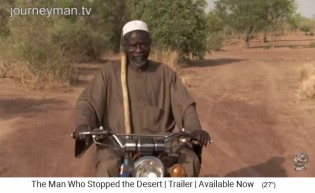 Pioneer Yacouba Sadabogo - and on the
motorcycle
Pioneer Yacouba Sadabogo - and on the
motorcycle
Eine neue Bedrohung kommt von der Hauptstadt der Region,
Ouahigouya, deren Ausbauprojekte den Bauernhof von Yacouba
bedrohen. Da kamen Vermessungsbeamte aus der Stadt und
haben einfach Territorien mit Betonpfosten abgesteckt.
Demnach würde Yacouba schätzungsweise 80% seines Landes
verlieren (54'11''). Dabei soll das Grab des Vaters
geteilt werden. Yacouba Sadabogo weiss nicht, wieso er das
verdient hat (54'55''). Auch das Getreidedepot soll Opfer
der Stadtplaner werden und zweigeteilt werden. Sie haben
in der Mitte des Hauses einen Betonpflock eingeschlagen.
Die Stadtverwaltung will scheinbar das Haus abreissen
(55'38''). Die Parzellen sind also so aufgeteilt, dass das
Erbe von Yacouba Sadabogo zerstört wird (56'0''). Dabei
hat Yacouba Sadabogo in den letzten 25 Jahren einen Wald
mit dem höchsten Artenreichtum geschaffen, der von einem
Bauern verwaltet wird (57'28'').
He himself does not know why he was given this leading
role in his country. This just happened (53'30'').
A new threat comes from the capital of the region,
Ouahigouya, whose expansion projects is threatening
Yacouba's farm. Surveyors came out of town and simply
staked out territories with concrete posts. It is
estimated that Yacouba would lose 80% of his territory
(54'11''). The grave of the father is to be divided.
Yacouba Sadabogo does not know why he deserved this
(54'55''). The grain depot will also become a victim of
urban planners and be divided into two parts. They smashed
a concrete peg in the middle of the house. The city
administration apparently wants to demolish the house
(55'38''). The plots are thus divided in such a way that
the heritage of Yacouba Sadabogo is destroyed (56'0'').
Over the last 25 years, Yacouba Sadabogo has created a
forest with the highest biodiversity, managed by a farmer
(57'28'').
13. Yacouba Sadabogo in Washington DC
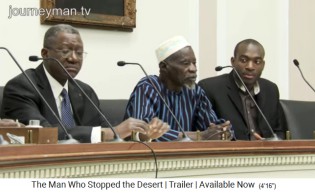 Yacouba Sadabogo speaks in Washington
DC at Oxfam
Yacouba Sadabogo speaks in Washington
DC at Oxfam
The Oxfam Foundation in Washington DC invited Yacouba with
a few farmers from his village to Washington DC to present
the Obama administration his new Zai technique (58'28'').
Perhaps elements of the modern Zai cultivation method will
be included in the Food Security Initiative of the Obama
government (59'4''). Yacouba was also received by the
Ambassador of Burkina Faso in Washington DC (1h2'19'').
Ambassador Paramanga Ernest Yongli praised Yacouba for
having pioneered food safety around the world (1h2'43'').
After returning to Burkina Faso, the city council gives in
and thinks that at least Yacouba's beautiful forest will
remain completely (1h3'35'').
Voices in the
movie:
|
|
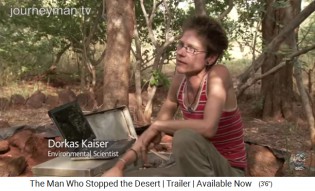
Environmental researcher Korkas Kaiser
observes and praises Yacouba Sadabogo in
Gourga, Burkina Faso
|

The Minister of Agriculture of Burkina Faso,
Ali Oudregou, praises Yacouba Sadabogo |

The Prime Minister of the Yatenga region in
Burkina Faso, Toogo Nabba Kougri, is praising
Yacouba Sadabogo
|
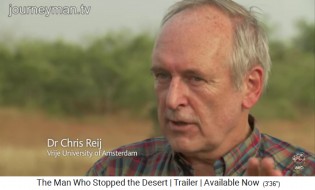
Dr. Chris Reij from the Free University of
Amsterdam is observing and praising the
research work of Yacouba Sadabogo
|
The movie: The Man Who Stopped the Desert
Film von Marc Dodd -
CBA-DFID Broadcast Media Scheme and FINHUMF - 1080
Films & Television Ltd MMX - 2010 -


